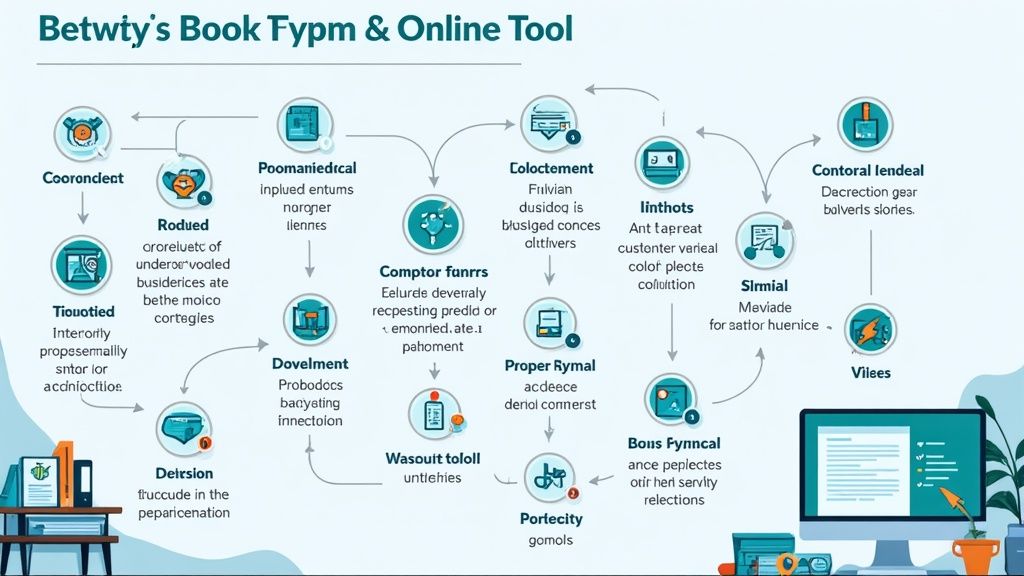Navigating Today’s Amazon Marketplace

Selling on Amazon takes a lot more than listing products and hoping for sales. With the average Amazon seller generating over $250,000 in annual revenue, having the right tools and strategies is essential for staying competitive. To succeed in this fast-paced marketplace, sellers need to master everything from market research and inventory management to customer service and marketing. Let’s explore the key tools that can help sellers build a thriving Amazon business.
Understanding the Power of the Right Tools
Good tools make a huge difference in running an efficient Amazon operation. With Fulfillment by Amazon (FBA) being used by 82% of sellers, having systems that work smoothly with FBA is crucial for managing inventory and shipments effectively. And considering Amazon sells around 7,800 items every minute, sellers need reliable tools to handle listings, pricing, and customer communication at scale. The right toolset helps sellers make smart decisions backed by data rather than guesswork.
Key Tool Categories for Amazon Sellers
Successful Amazon sellers rely on different types of tools to manage various aspects of their business:
- Product Research and Market Intelligence: Tools like Jungle Scout and Helium 10 help sellers find profitable products by analyzing market trends and competition. For example, these tools show which keywords are trending up or down and reveal emerging product opportunities.
- Listing Optimization and Keyword Research: Creating listings that convert starts with finding the right keywords. Tools like Sonar and Keyword Tool Dominator provide search volume data and competition metrics so sellers can optimize their titles and descriptions for maximum visibility.
- Inventory Management and FBA Optimization: Running out of stock or having too much inventory both hurt profits. Tools like RestockPro and Forecastly help predict demand patterns and set optimal reorder points. This keeps inventory levels balanced and FBA storage costs under control.
- Pricing and Profit Analytics: Staying competitive while maintaining margins requires constant price monitoring. Tools like RepricerExpress and Sellerboard automatically adjust prices based on competitor moves and profitability targets. The data shows which products deliver the best returns.
- Marketing and Advertising Management: Running effective Amazon ads means tracking performance and optimizing spend. Tools like Sellics and PPC Scope provide detailed campaign analytics so sellers can focus budget on what works best. They show which keywords and targeting strategies drive the most sales.
- Customer Feedback and Review Management: Building a strong seller reputation depends on proactive customer service. Tools like Feedback Genius and FeedbackFive automate review requests and help resolve issues quickly. Happy customers leave better reviews, leading to increased sales.
Using the right combination of tools gives sellers the data and automation they need to build a successful Amazon business. While the tools require an investment, they help sellers work more efficiently and make decisions that boost their bottom line.
Mastering Product Research and Market Intelligence

Finding successful products is essential for any Amazon seller looking to build a profitable business. Effective product research goes beyond basic keyword analysis – it requires a deep understanding of market dynamics, consumer behavior, and profit potential. The right research tools make this process much more effective by providing concrete data to inform product decisions.
Uncovering Hidden Opportunities With Advanced Analytics
Successful Amazon sellers use specialized analytics tools to find opportunities others miss. For example, Jungle Scout’s Opportunity Finder helps sellers explore niche markets by filtering products based on actual demand and competition levels. Similarly, Helium 10’s Black Box tool lets sellers search for products using specific criteria like revenue, price point, and review count. This focused approach helps sellers spot profitable niches before they become overcrowded.
Validating Product Decisions With Data-Driven Insights
Smart sellers rely on solid data rather than guesswork when choosing products. They look at multiple data points like historical sales trends, competitive analysis, and market share estimates to fully understand the opportunity. This thorough approach helps avoid costly inventory mistakes – no one wants to invest in stock only to discover weak demand or too much competition. Good market research tools provide the key insights needed to make confident product decisions.
Spotting Emerging Trends Before Competitors
Staying competitive means identifying new trends early. By tracking changes in search volume, analyzing customer reviews, and monitoring competitor activities, sellers can spot shifts in what buyers want. This allows them to adapt their product offerings ahead of others. For instance, when certain product features get consistently positive mentions in reviews, it signals an emerging customer preference that sellers can address in their products.
Building a Winning Product Research Process
Having a systematic approach to product research leads to consistent success on Amazon. By combining insights from multiple research tools with market knowledge, sellers can reliably identify winning products while minimizing risks. A well-researched product selection provides the foundation for effective marketing, pricing, and customer service strategies. With the right tools and processes in place, finding profitable products becomes much more predictable and less about chance.
Optimal Fulfillment By Amazon (FBA) Management
Optimizing Your FBA Operations
After finding the right products to sell, managing your Fulfillment by Amazon (FBA) operations effectively becomes critical for success. Smart inventory management, efficient shipping processes, and careful control of storage costs allow sellers to focus on growing their business rather than getting bogged down in logistics. Having the right tools to handle these aspects can make a major difference in your profitability.
Mastering Inventory Management with the Right Tools
Getting inventory levels right is essential – too much stock ties up capital and incurs storage fees, while too little means lost sales and lower search rankings. Tools like RestockPro help take the guesswork out of inventory planning by analyzing your sales history, seasonal patterns, and market trends. Their forecasting capabilities let you maintain optimal stock levels to maximize revenue while minimizing carrying costs. Think of it as having a smart inventory system that helps you stay ahead of demand.
Streamlining FBA Shipping and Logistics
Getting products to Amazon’s warehouses efficiently keeps costs down and ensures items are available when customers want them. Tools like Forecastly connect directly with FBA to optimize shipments based on predicted demand and warehouse space. They also simplify tasks like creating shipping labels, monitoring deliveries, and processing returns. This automation saves valuable time and reduces shipping mistakes that can hurt your bottom line.
Minimizing Storage Fees and Maximizing Inventory Turnover
Storage fees at Amazon’s warehouses can quickly eat into profits if not managed carefully. The best inventory tools provide clear visibility into your storage costs and help identify ways to reduce them. You can see which products take up the most space and how long they’ve been sitting, allowing you to make smart decisions about inventory levels. You may need to adjust prices on slow-moving items to improve turnover and avoid paying unnecessary fees. Keeping inventory moving efficiently is key to maintaining healthy margins.
Scaling FBA Operations Through Automation
As your sales volume grows, trying to manage everything manually becomes increasingly difficult and error-prone. Quality automation tools can handle routine tasks like reordering inventory, fulfilling orders, and communicating with customers. This frees up your time to focus on strategic priorities like finding new products and marketing existing ones. For sellers aiming to expand their business, investing in solid automation capabilities creates a foundation for sustainable growth without getting overwhelmed by day-to-day operations.
Strategic Pricing and Profit Optimization

Getting your pricing right is essential for success as an Amazon seller. Simply matching competitor prices often leads to unsustainable price wars that eat away at profits. Smart sellers use data-driven tools to develop strategic pricing that maximizes both sales and margins.
The Power of Automated Repricing
Keeping prices competitive on Amazon requires constant attention. That’s where automated repricing tools like RepricerExpress and Sellerboard come in handy – they monitor competitor prices 24/7 and automatically adjust your listings based on rules you set. For example, you might configure the tool to always price 5% below your lowest competitor while maintaining your target profit margin. This automated approach ensures you stay competitive and win sales without manually checking prices all day.
Unlocking Profit Insights with Analytics
Making smart pricing decisions requires understanding your true costs and profitability. Detailed analytics tools show you exactly what you’re spending on FBA fees, advertising, and inventory for each product. With this data, you can identify which items generate the most profit – sometimes products with lower sales volume have better margins due to lower costs. This helps you make informed choices about where to invest your inventory dollars and promotional budget. For perspective, 87% of Amazon sellers reported being profitable in 2023 by carefully tracking and optimizing their numbers.
Maintaining Margins During Peak Seasons and Competitive Pressures
Holiday seasons and major sales events bring both opportunities and challenges. While demand spikes create the potential for higher sales, intense competition can squeeze margins. Analytics tools help you forecast demand patterns and adjust pricing strategically during these crucial periods. You can also identify which products are most sensitive to price changes and develop targeted strategies to protect profitability even when competition heats up. With the average Amazon seller generating over $250,000 in annual revenue, even small improvements in margin management can significantly impact your bottom line. Having the right data empowers you to make pricing decisions that balance short-term sales with long-term profitability.
Building Your PPC and Marketing Engine
Getting your products found and sold on Amazon takes more than just polished listings and good inventory management. You need a solid marketing strategy that brings in the right shoppers and turns them into buyers. The most successful sellers have learned that combining organic visibility with strategic advertising delivers the best results.
Combining PPC Management Platforms With Listing Optimization
Smart sellers get better results by using PPC management tools alongside listing optimization software. This approach helps find the best keywords for ads and seamlessly incorporate them throughout product listings – from titles to backend search terms. For example, you can use Sonar and Keyword Tool Dominator to identify high-performing keywords for your niche. Then apply those insights to optimize both your organic listings and PPC campaigns through platforms like Sellics and PPC Scope. When your organic and paid strategies work together, you reach more of your ideal customers.
Scaling Your Marketing Efforts and Measuring True ROAS
As you grow, managing more complex marketing campaigns efficiently becomes essential. The right tools help automate bidding, optimize targeting, and analyze performance in detail. Pairing PPC platforms with profit tracking tools like Sellerboard gives you an accurate picture of your true return on ad spend (ROAS) by factoring in all your costs. This data helps you make smarter decisions about where to focus your budget. For instance, you can spot which keywords and targeting options convert best and adjust bids accordingly to maximize results.
Identifying Effective Keywords and Targeting Options
Finding the right keywords and targeting settings is crucial for Amazon advertising success. This requires understanding both how customers search and what your competition is doing. Advanced tools provide insights into search volume, keyword relevance, and competitor bidding patterns. This helps you discover opportunities others miss, like long-tail keywords with lower competition but strong buying intent. You can also refine your audience targeting based on demographics, purchase history, and browsing behavior to reach the most qualified potential customers. Taking a data-driven approach to keywords and targeting helps create more efficient campaigns that deliver sustainable growth over time. The key is regularly analyzing performance data to optimize what’s working and adjust what isn’t. This methodical approach builds a strong foundation for long-term success in Amazon’s competitive marketplace.
Elevating Customer Experience and Brand Reputation

Success on Amazon requires more than optimized listings and inventory management. Customer experience and brand reputation are essential elements that drive sustainable growth. The right tools help sellers build strong customer relationships that lead to lasting success. In fact, 87% of Amazon sellers reported being profitable in 2023, with excellent customer service playing a key role.
Automating Feedback and Communication for Better Customer Service
Smart automation of customer feedback and communication helps sellers provide great service at scale. Tools like Feedback Genius and FeedbackFive make it easy to request feedback after purchases. This gives sellers insights into customer satisfaction and helps catch issues early. For instance, a simple follow-up email can identify shipping problems or product defects before they turn into negative reviews. These tools also help sellers share product information, answer common questions, and make personalized suggestions to customers. The result is stronger customer relationships that encourage repeat business.
Managing Reviews to Build Trust
Reviews play a vital role in building credibility on Amazon. Good review management tools help sellers collect honest feedback while following Amazon’s guidelines. When shoppers see positive reviews from real customers, it builds their confidence to buy. Think of reviews as digital word-of-mouth – one good review can influence thousands of potential customers. Of course, negative reviews need quick, professional responses too. The right tools help sellers spot and address concerns promptly, showing their commitment to customer satisfaction. This hands-on approach helps minimize negative impacts while building customer trust.
Growing Customer Service Without Losing the Personal Touch
As sales increase, maintaining quality customer service becomes challenging. The best tools help sellers handle more customer questions while keeping interactions personal. Many tools offer pre-written responses for common questions, giving sellers more time for unique issues. Some tools also work with other customer service platforms to create a central hub for all customer communications. This means sellers can grow their business while still giving each customer individual attention.
Working With an Experienced eCommerce Partner
For comprehensive support, working with an established eCommerce agency like eStore Factory can make a real difference. With years of Amazon experience, eStore Factory helps sellers with everything from product listings to advertising to account management. Their team knows what it takes to succeed on Amazon and can help implement the right tools and strategies to improve customer experience and strengthen your brand.
Ready to take your Amazon business to the next level? Learn how eStore Factory’s complete service package can help you deliver outstanding customer experiences: eStore Factory

